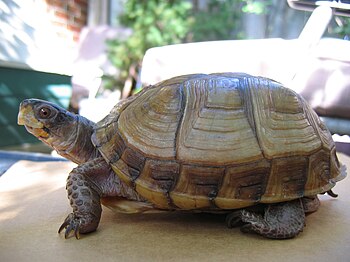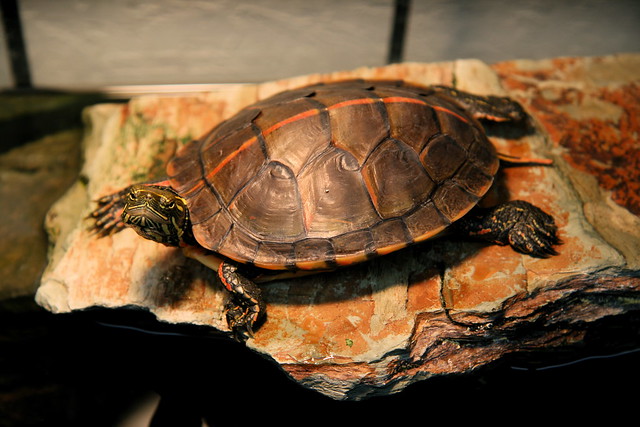 |
| A female North American three-toed box turtle (Terrapene Carolina triunguis) (Photo: Wikipedia) |
Box turtles tend to fall somewhere between the truly aquatic turtles and the terrestrial tortoises with their need for access to bodies of water in which to soak and their need for wooded and grassland areas with moist humid soil. Box turtle forage for food on land and spend the time they sleep dug into the earth in burrows, under logs, or wedged under rocks.
HOUSING:
Box turtles need a good size enclosure in order to provide for the proper range of heating and humidity. The smallest size indoor enclosure for one box turtle to be kept in is 3 x 3 x 2 feet. For two turtles, the minimum size should be at least 4 x 4 x 2 feet. Aquariums are not appropriate housing for an adult box turtle. Babies may be kept in aquariums, but as they grow larger enclosures are needed. Create a land area using 2 to 3 inches of good quality plain sterile potting soil slightly moistened. Do not use backyard dirt soil from a garden. Mix the soil with cypress mulch. Do not use coarse substrates such are gravel or sand, as these tend to scratch the shell and open the way for bacterial infections. Box turtles require a hide box in which to get away from it all and feel secure. A good size box in one corner of the enclosure, filled with alfalfa hay in which to burrow. is essential. The hide box can be anything from a cardboard box to a plastic container with a door cut into it. A water area must be provided that is deep enough that the water comes to just about the nose of the turtle. It doesn't need to be swimming, just soaking. If using a kitty litter pan, it is best to sink this into the substrate and provide a ramp to get in and get out for the turtle. The water area must be kept clean at all times. Box turtles not only use the water to soak in but also relieve themselves in.
LIGHTING:
Full spectrum lighting is required for indoor enclosures. Full spectrum light mimics the beneficial effects of natural sunlight, enabling the turtle to metabolize vitamin D3. The full spectrum lighting is an essential part of the calcium metabolization process. Without the specific wavelengths and proper diet, calcium deficiencies will result which may ultimately prove fatal. Box Turtles need 12 to 14 hours of light each day. NOTE: UV waves cannot pass through glass, and 40% of the available waves are lost when the light passes through an aluminum screen, try to have the light shining directly on them.
HUMIDITY/TEMPERATURE:
Day Time temps: 85 to 88 degrees
Night Time temps 70 to 75 degrees.
Most box turtles require a relative humidity of 60 to 80% in at least one area of their enclosure. A turtle that is not provided with the correct humidity often suffers from infected and swollen eyes and ear infections. Providing humidity is simple, in one corner of the enclosure provide some peat moss and wet it down with water until it is fairly moist. A hiding area, such as a cardboard box or large plastic container with ventilation holes should be placed over the wet peat moss. Be sure to check the moss constantly to ensure it is moist and has not dried out.
DIET:
It is best to offer food after the turtle has had a few hours to warm up in the morning. Young turtle requires feeding on a daily basis, while an adult can be fed every other day. Make sure you vary their diet with both plant and animal matter. Vitamin supplements should be added twice a week.
Plants: A variety of vegetables, greens, and fruits are a must. Such as a "salad" of carrots, squash green beans, strawberries, cranberries, blackberries, cherries, and plums. Some cantaloupe (with the rind), mustard greens, dandelions, and collard greens can also be mixed in. For treats, you can add flowers like hibiscus, rose petals, and geraniums.
Meat: High quality low-fat canned dog food, finely chopped cooked chicken or raw beef heart. Live food can also be offered, like mealworms and crickets.
Young turtles require more animal matter in their diet due to their need for protein. As they grow into adults this should be reduced over time to no more than 10% of their total diet.
BRUMATION/HIBERNATION:
It is a good idea to allow your box turtle to hibernate, especially if you keep it in an outdoor enclosure during the summer months.This is to allow the box turtles internal clock to remain normal. If you choose not to hibernate the turtle, you must keep it warm and provide plenty of UV lighting along with their normal dietary needs.
To prepare a box turtle for hibernation, do not feed the animal for two weeks, but keep the heat on to allow the animal to fully digest any food remaining in its stomach and intestinal tract. Soak the box turtle in a shallow container of lukewarm water a few times during this period for about 10 minutes, this will help to hydrate the animal and to remove any food left in their system. Box turtle hibernated with food still present in their intestinal tract can die from massive infections as the food rots inside them.
Hibernating box turtles indoor requires a hibernation box. A cardboard box half filled with moist sterile potting soil or peat moss with holes punched in the sides for aeration is an appropriate hibernation box. After all the food has been cleared from the turtle's system, introduce the turtle to the hibernation box. If the box turtle buries down into the substrate and remains still, it is ready for hibernation. If the animal is moving restlessly around after 20 minutes in the box, return it to its enclosure, wait a few days and try again. If the box turtle is ready, move it to an unheated room, such as a garage, where the temperature will remain between 40 to 55 degrees. Check the box turtle weekly to make sure it has not surfaced prematurely. Box turtles usually come out of hibernation after experiencing temperature above 65 degrees for a few days. After the turtle comes out of hibernation, return it to its regular enclosure, provide water, warm it up for a couple of days, and then offer some food. Pay close attention to the turtle during the time after hibernation to observe for any health problems that may occur.








